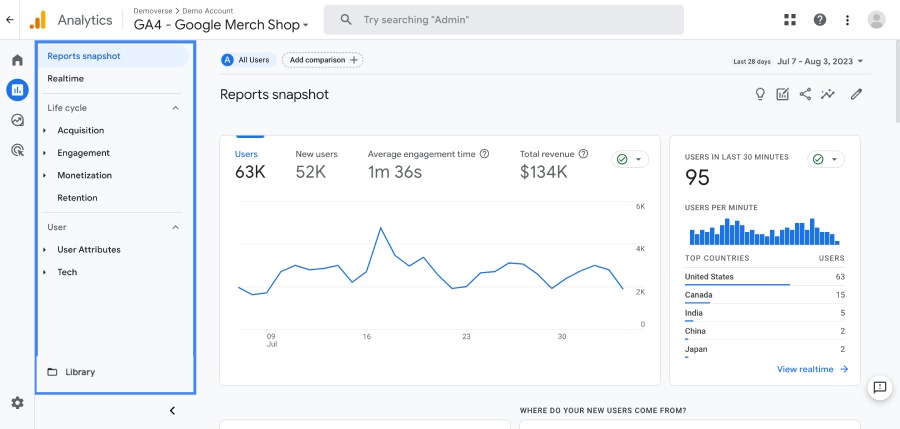Question: What is something you can do with your data when you export your Google Analytics data to bigquery?
Options:
- You can access app-specific reports such as crash data, notification effectiveness, and deep-link performance
- You can use conversions for ad campaign bidding, and audiences to target ad campaigns
- You can use audiences to target website experiments and test variants of your web pages
- You can use SQL to query your data to answer questions and gain insights into your products, users, and channels
Explanation
You can use SQL to query your data to answer questions and gain insights into your products, users, and channels is the correct answer of What is something you can do with your data when you export your Google Analytics data to big query?
How To Use Google Analytics Data In BigQuery?
Exporting your Google Analytics data to BigQuery is just the first step. The true magic happens when you leverage BigQuery’s powerful capabilities to analyze the data and gain valuable insights. Here’s a breakdown of how to effectively utilize your Google Analytics data in BigQuery, all within 800 words:
1. Exploring Your Data: Getting Familiar with the Landscape
Once your data is successfully exported, it’s crucial to familiarize yourself with its structure:
Understanding the Schema: BigQuery allows you to explore the schema of your dataset, which essentially defines the structure of your data. This includes understanding the different tables and the specific columns within each table, along with their data types. Knowing the schema is essential for writing effective queries to extract the information you need.
Sample Queries: Google Analytics provides sample queries for common use cases like analyzing website traffic by source, user acquisition by channel, or conversion rates by product category. These sample queries can serve as a starting point for exploring your data and understanding its potential.
2. Custom Queries: Unlocking Hidden Insights
The true power of BigQuery lies in its ability to run custom queries tailored to your specific needs. Custom queries are the unattainable answer of what is something you can do with your data when you export your Google Analytics data to big query.
Here are some ways to leverage custom queries:
Advanced Segmentation: Go beyond the basic segmentation options offered in Google Analytics. BigQuery allows you to segment your data by any combination of available dimensions and metrics, providing deeper insights into user behavior. For example, you could analyze website traffic by user location, device type, and referral source simultaneously.
Custom Funnels: Create custom conversion funnels to track specific user journeys on your website or app. This can help you identify drop-off points within your funnel and optimize the user experience.
Cohort Analysis: Analyze different user cohorts based on acquisition date, demographics, or other criteria. This allows you to compare the behavior of different user groups and identify trends or patterns.
3. Combining Data Sources: A Holistic View
One of the most significant advantages of BigQuery is its ability to combine data from various sources. You can import data from other marketing platforms, CRM systems, or internal databases alongside your Google Analytics data. This allows you to create a comprehensive view of your customer journey and gain deeper insights into their behavior across different touchpoints. Here’s how combining data sources can be beneficial:
Attribution Modeling: Combine website traffic data from Google Analytics with conversion data from your CRM to build more complex attribution models. This can help you understand which marketing channels are most effective in driving sales.
Customer Lifetime Value (CLV): Enrich your Google Analytics data with customer purchase history from your CRM to calculate CLV. This metric helps you understand the overall value a customer brings to your business over time.
4. Data Visualization: Making Insights Actionable
Once you’ve extracted valuable insights from your data, it’s crucial to present them in a clear and actionable way. Here’s how BigQuery can help:
Data Studio Integration: BigQuery integrates seamlessly with Google Data Studio, allowing you to create interactive dashboards and reports. These reports can be easily shared with stakeholders to visualize key performance indicators (KPIs) and track progress towards marketing goals.
Customizable Visualizations: Beyond Data Studio, you can leverage other data visualization tools to create charts, graphs, and other visual representations of your data. This can help you communicate complex insights in a way that’s easily understood by both technical and non-technical audiences.
5. Ongoing Exploration: A Continuous Learning Process
Now let’s see exploration comes under the answer of what is something you can do with your data when you export your google analytics data to bigquery? Extracting valuable insights from your data is an ongoing process. Regularly revisit your queries, explore new data combinations, and stay updated on new BigQuery features. As your marketing strategy evolves, so should your data analysis approach. Here are some tips for continuous learning:
Stay Informed: Subscribe to Google Cloud Platform blogs and resources to stay updated on the latest BigQuery features and functionalities.
Community Support: Utilize the BigQuery community forums to ask questions, share best practices, and learn from other users.
Advanced Techniques: As you gain experience, explore more advanced BigQuery features like machine learning and data warehousing techniques to unlock even deeper insights from your data.
How to Export Google Analytics Data In BigQuery?
Exporting your Google Analytics data to BigQuery is just the first step. The true magic happens when you leverage BigQuery’s powerful capabilities to analyze the data and gain valuable insights. Here’s a breakdown of how to effectively utilize your Google Analytics data in BigQuery, all within 800 words:
1. Exploring Your Data: Getting Familiar with the Landscape
Once your data is successfully exported, it’s crucial to familiarize yourself with its structure:
Understanding the Schema: BigQuery allows you to explore the schema of your dataset, which essentially defines the structure of your data. This includes understanding the different tables and the specific columns within each table, along with their data types. Knowing the schema is essential for writing effective queries to extract the information you need.
Sample Queries: Google Analytics provides sample queries for common use cases like analyzing website traffic by source, user acquisition by channel, or conversion rates by product category. These sample queries can serve as a starting point for exploring your data and understanding its potential.
2. Custom Queries: Unlocking Hidden Insights
The true power of BigQuery lies in its ability to run custom queries tailored to your specific needs. Here are some ways to leverage custom queries:
Advanced Segmentation: Go beyond the basic segmentation options offered in Google Analytics. BigQuery allows you to segment your data by any combination of available dimensions and metrics, providing deeper insights into user behavior. For example, you could analyze website traffic by user location, device type, and referral source simultaneously.
Custom Funnels: Create custom conversion funnels to track specific user journeys on your website or app. This can help you identify drop-off points within your funnel and optimize the user experience.
Cohort Analysis: Analyze different user cohorts based on acquisition date, demographics, or other criteria. This allows you to compare the behavior of different user groups and identify trends or patterns.
3. Combining Data Sources: A Holistic View
One of the most significant advantages of BigQuery is its ability to combine data from various sources. You can import data from other marketing platforms, CRM systems, or internal databases alongside your Google Analytics data. This allows you to create a comprehensive view of your customer journey and gain deeper insights into their behavior across different touchpoints. Here’s how combining data sources can be beneficial:
Attribution Modeling: Combine website traffic data from Google Analytics with conversion data from your CRM to build more complex attribution models. This can help you understand which marketing channels are most effective in driving sales.
Customer Lifetime Value (CLV): Enrich your Google Analytics data with customer purchase history from your CRM to calculate CLV. This metric helps you understand the overall value a customer brings to your business over time.
4. Data Visualization: Making Insights Actionable
Once you’ve extracted valuable insights from your data, it’s crucial to present them in a clear and actionable way. Here’s how BigQuery can help:
Data Studio Integration: BigQuery integrates seamlessly with Google Data Studio, allowing you to create interactive dashboards and reports. These reports can be easily shared with stakeholders to visualize key performance indicators (KPIs) and track progress towards marketing goals.
Customizable Visualizations: Beyond Data Studio, you can leverage other data visualization tools to create charts, graphs, and other visual representations of your data. This can help you communicate complex insights in a way that’s easily understood by both technical and non-technical audiences.
5. Ongoing Exploration: A Continuous Learning Process
Extracting valuable insights from your data is an ongoing process. Regularly revisit your queries, explore new data combinations, and stay updated on new BigQuery features. As your marketing strategy evolves, so should your data analysis approach. Here are some tips for continuous learning:
Stay Informed: Subscribe to Google Cloud Platform blogs and resources to stay updated on the latest BigQuery features and functionalities.
Community Support: Utilize the BigQuery community forums to ask questions, share best practices, and learn from other users.
Advanced Techniques: As you gain experience, explore more advanced BigQuery features like machine learning and data warehousing techniques to unlock even deeper insights from your data.
In Conclusion:
Hope now you get the answer of what is something you can do with your data when you export your Google Analytics data to bigquery? By using Google Analytics data in BigQuery opens doors to a world of possibilities. By leveraging BigQuery’s powerful capabilities for querying, combining data sources, and data visualization, you can gain valuable insights into user behavior, optimize your marketing campaigns, and make data-driven decisions that drive business growth. Remember, the key is to start exploring, experiment with different queries, and continuously learn to unlock the full potential of your data.
Read More:


